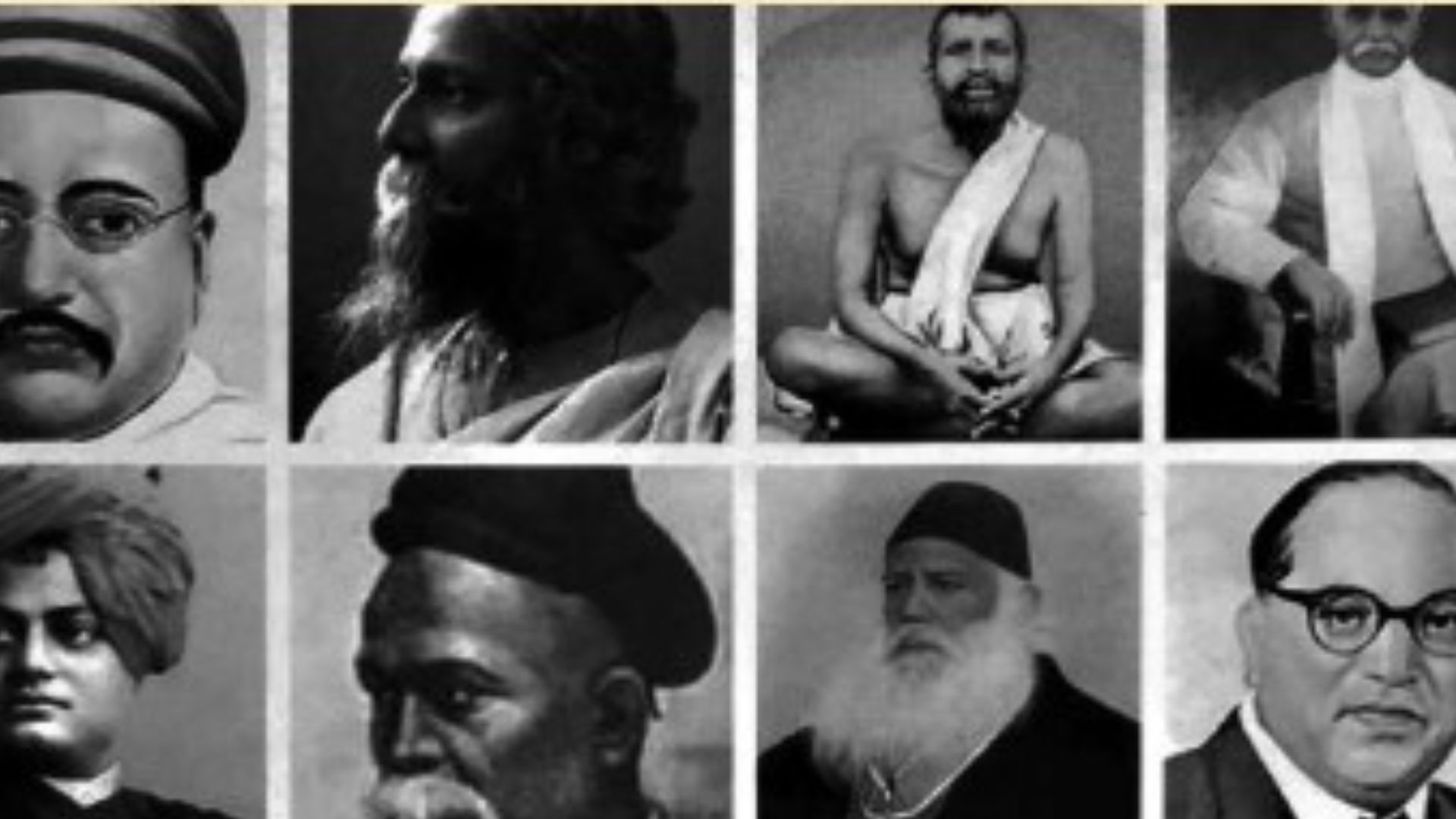Introduction : In the bustling streets of 19th-century India, a quiet revolution was taking shape. Amidst the rigid social structures and deeply rooted religious practices that had long defined the subcontinent, a new generation of reformers emerged, determined to challenge the status quo and usher in a new era of progress. These social and religious reform movements, spearheaded by visionary leaders, would go on to reshape the very fabric of Indian society, leaving an indelible mark on the country’s trajectory.
The Winds of Change
The backdrop for this transformative era was a nation in flux. The colonial presence had introduced a host of modern ideas, from democracy and liberty to social and economic equality. These foreign concepts collided with the long-standing traditions and beliefs that had shaped Indian society for centuries, creating a palpable tension that could no longer be ignored.
At the forefront of this transformation stood figures like Raja Ram Mohan Roy, Ishwar Chandra Vidyasagar, and Dayanand Saraswati – pioneers who recognized the urgent need for change. Driven by a deep well of intellect and moral conviction, they embarked on a crusade to reform the ills that had long plagued the Indian landscape.
The Reformist Movements:
The Brahmo Samaj
One of the most influential reformist movements of the time was the Brahmo Samaj, founded by Raja Ram Mohan Roy in 1828. Rejecting the rigid dogma and ritualistic practices of traditional Hinduism, the Brahmo Samaj championed the worship of a single, eternal God, and advocated for a more rational and inclusive approach to spirituality. “Our aim is to free people from the shackles of superstition and bring them closer to the divine through meaningful contemplation and dialogue,” Roy proclaimed, rallying a growing following of educated elites and social progressives.
The Prarthana Samaj
Alongside the Brahmo Samaj, other reformist organizations, such as the Prarthana Samaj in Bombay, joined the chorus for change. Led by figures like R.C. Bhandarkar and Justice Mahadev Govind Ranade, these groups targeted deeply entrenched social ills, from the caste system and child marriage to the lack of education for women and the oppression of the underprivileged. “We cannot hope to move forward as a nation if we continue to ignore the suffering of our fellow citizens,” Ranade declared passionately. “It is our duty to challenge the injustices that have been normalized for far too long.”
The Revivalist Movements
The reformist movements’ impact was not limited to the social sphere alone. They also sought to revive and reinterpret India’s rich cultural and religious heritage, drawing inspiration from the country’s ancient texts and philosophies. The Arya Samaj, founded by Swami Dayanand Saraswati, championed a return to the “Vedic” roots of Hinduism, while the Deoband movement in northern India advocated for a more puritanical and socially conscious form of Islam.
These revivalist movements, while distinct in their approaches, shared a common goal: to reclaim the true essence of their respective faiths and use it as a force for positive change. “We must not be shackled by the weight of tradition,” Dayanand Saraswati argued. “Instead, we must embrace the timeless wisdom of our ancestors and apply it to the challenges of the modern world.”
From Social Reform to National Awakening
The impact of these social and religious reform movements was far-reaching, transcending the realms of spirituality and social welfare. They laid the groundwork for a new era of enlightenment and national consciousness, inspiring a generation of thinkers, writers, and activists to challenge the status quo and imagine a brighter future for India.
One such individual was Rabindranath Tagore, the renowned poet and philosopher who emerged from the Brahmo Samaj tradition. Tagore’s multifaceted contributions, from his literary masterpieces to his pioneering educational initiatives, reflected the reformist spirit that had taken hold of the nation. “We must not be content with merely fixing the symptoms of our societal ills,” Tagore asserted. “We must dig deeper, to the very roots of our collective consciousness, and cultivate a new vision for our shared destiny.”
The reverberations of these reform movements were felt across the length and breadth of India, inspiring a wave of grassroots activism and political awakening. As the 19th century drew to a close, a new generation of nationalists, fueled by the embers of social and religious reform, began to coalesce, setting the stage for the country’s pivotal struggle for independence.
The Legacy of Reform
In the years that followed, the legacies of the Brahmo Samaj, Prarthana Samaj, Arya Samaj, and other reform movements would continue to shape the trajectory of Indian society, influencing the fields of education, women’s rights, and the fight against caste-based discrimination. Their impact, though often overlooked in the grand narratives of history, remains a testament to the power of ideas to transform a nation.
As we reflect on this transformative era, it becomes evident that the social and religious reform movements of 19th-century India were not mere historical footnotes, but rather the harbingers of a new dawn – a dawn that would usher in a more equitable, enlightened, and empowered India. Their legacy continues to inspire us, reminding us that progress is not merely a destination, but a constant journey of introspection, courage, and unwavering commitment to the ideals of justice, harmony, and human dignity.
The promoter of Social Justice
Mahadev Govind Ranade: A Holistic Approach to Reform
Among the prominent figures at the forefront of this social and religious transformation was Mahadev Govind Ranade. As the founder of the Widow Remarriage Association and the Deccan Education Society, Ranade dedicated his life to challenging the unjust practices that had long oppressed the most vulnerable members of Indian society.
Ranade’s core belief was that religious reform and social reform were inextricably linked. “If religious ideas remain rigid,” he argued, “there can be no true progress in the social, economic, and political spheres.” This conviction drove him to establish the Poona Sarvajanik Sabha, a platform for public discourse on a wide range of pressing issues.
Ranade’s tireless efforts to champion the rights of widows and promote women’s education were not merely driven by a sense of moral obligation, but by a deep-rooted conviction that the emancipation of India hinged on the empowerment of its people, regardless of caste or gender. Through his work, he laid the groundwork for a more equitable and inclusive society, paving the way for future generations of social reformers.
Jyotiba Phule: Challenging the Citadel of Brahminical Supremacy
While the reformist movements of the Brahmo Samaj and Prarthana Samaj sought to transform Indian society from within the existing religious framework, Jyotiba Phule took a more radical approach. In 1873, he founded the Satyashodhak Samaj (Truth Seekers’ Society), a powerful movement that directly challenged the dominance of the Brahmin caste and the oppressive social structures they upheld.
Phule’s seminal works, “Sarvajanik Satyadharma” and “Gulamgiri,” became rallying cries for the masses, inspiring a new sense of identity and self-worth among the marginalized communities. Rejecting the traditional symbols of Rama and the Brahminical order, Phule championed the figure of Rajah Bali as a counterpoint, representing the inherent dignity and autonomy of the oppressed.
Through the Satyashodhak Samaj, Phule relentlessly advocated for the abolition of the caste system and the expansion of educational opportunities for women and the lower castes. His unwavering commitment to social justice and his ability to galvanize the grassroots made him a formidable force, paving the way for a more egalitarian and inclusive vision of Indian society.
Reviving the Past, Shaping the Future
The Arya Samaj:
While the reformist movements sought to challenge the societal ills of the time, the Arya Samaj took a different approach – one that aimed to revive the ancient wisdom of the Vedas and reinterpret them for the modern era. Established by Swami Dayanand Saraswati in 1875, the Arya Samaj movement was a reaction to the growing Western influence in India, but its impact went far beyond a simple reaffirmation of tradition.
At the core of the Arya Samaj’s philosophy was the belief in one supreme God, the infallibility of the Vedas, and the importance of individual spiritual development. Swami Dayanand’s teachings emphasized the need for a return to the purity of the Vedic era, but he also recognized the value of Western education and technological advancement. This fusion of ancient wisdom and modern progress was embodied in the Dayanand Anglo-Vedic (DAV) schools, which sought to impart a holistic education that combined the best of both worlds.
The Arya Samaj’s influence extended well beyond the realm of religion. By instilling a sense of self-respect and confidence in the Hindu community, it helped to undermine the myth of Western superiority and paved the way for a renewed pride in India’s cultural heritage. The Shuddhi movement, aimed at reconverting people to Hinduism, further solidified the Arya Samaj’s position as a force to be reckoned with, though it also contributed to the increasing communalization of social life.
The Ramakrishna Movement
In contrast to the Arya Samaj’s focus on Vedic revivalism, the Ramakrishna Movement, inspired by the teachings of the mystic Ramakrishna Paramhansa, emphasized the universal message of Vedanta and the importance of service to humanity. Swami Vivekananda, the movement’s most prominent proponent, built upon Ramakrishna’s vision to establish the Ramakrishna Mission in 1897, dedicated to both spiritual and social transformation.
Vivekananda’s vision was one of a harmonious synthesis between the realms of the sacred and the secular. He believed that the “service of jiva (living beings) is the worship of Shiva,” and that true spirituality could only be manifested through a commitment to the betterment of all. The Ramakrishna Mission, under Vivekananda’s leadership, undertook extensive educational and philanthropic work, providing a model of how ancient wisdom and modern humanitarianism could be seamlessly woven together.
The Ramakrishna Movement’s impact transcended the borders of India, as Vivekananda’s charismatic presence and powerful message resonated globally. His representation of India at the 1893 Parliament of Religions in Chicago was a watershed moment, showcasing the richness and diversity of the country’s spiritual traditions to the world.
The Legacies that Endure
As we reflect on the tapestry of social and religious reform movements that transformed 19th-century India, it becomes clear that these visionary leaders, though often overlooked in the grand narratives of history, have left an indelible mark on the nation’s trajectory. From the rationalist ideals of the Brahmo Samaj to the revolutionary spirit of the Satyashodhak Samaj, each movement contributed to the awakening of India’s collective consciousness, paving the way for a more equitable, enlightened, and empowered future.
The legacies of these reform movements continue to reverberate through the pages of history, inspiring successive generations of thinkers, activists, and change-makers. Their unwavering commitment to social justice, women’s empowerment, and the preservation of cultural identity remains a testament to the power of ideas to shape the course of a nation. As we navigate the challenges of the modern era, the lessons and insights gleaned from these historical figures serve as a guiding light, reminding us that true progress is not merely a destination, but a constant journey of introspection, courage, and a relentless pursuit of a more just and harmonious world.






